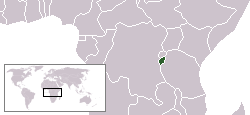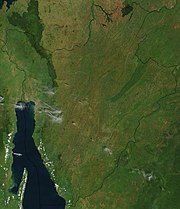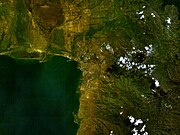Burundi
From Wikipedia, the free encyclopedia.
|
|||||
| Motto: Unité, Travail, Progrès (French: Unity, Work, Progress) | |||||
| Anthem: Burundi bwacu | |||||
 |
|||||
| Capital | Bujumbura |
||||
| Largest city | Bujumbura | ||||
| Official languages | Kirundi and French. Swahili is widely spoken. | ||||
| Government | Republic Pierre Nkurunziza |
||||
| Independence - Date |
From Belgium July 1, 1962 |
||||
| Area • Total • Water (%) |
27,830 km² (142nd) 7.8% |
||||
| Population • 2003 est. • 1978 census • Density |
6,054,714 (99th) 3,589,434 206.1/km² (52) |
||||
| GDP (PPP) • Total • Per capita |
2003 estimate 4,5171 (142) 627 (163) |
||||
| Currency | Burundi franc (FBu) (BIF) |
||||
| Time zone • Summer (DST) |
EET (UTC+2) not observed (UTC+2) |
||||
| Internet TLD | .bi | ||||
| Calling code | +257 |
||||
| 1 Estimate is based on regression; other PPP figures are extrapolated from the latest International Comparison Programme benchmark estimates. | |||||
The Republic of Burundi (formerly Urundi) is a small nation in the Great Lakes region of Africa. It is bordered by Rwanda on the north, Tanzania on the south and east, and the Democratic Republic of the Congo on the west. Although the country is landlocked, much of its western border is adjacent to Lake Tanganyika. The country's name derives from its Bantu language, Kirundi.
Geographically isolated, facing population pressures and having sparse resources, Burundi is one of the poorest and most conflict-ridden countries in Africa and in the world. Its small size belies the magnitude of the problems it faces in reconciling the claims of the Tutsi minority with the Hutu majority.
Contents |
History
- Main article: History of Burundi
Burundi existed as an independent kingdom from the 16th century. In 1903, it became a German colony and passed to Belgium in World War I. It was part of the Belgian League of Nations mandate of Ruanda-Urundi in 1923, later a United Nations Trust Territory under Belgian administrative authority following World War II. The origins of Burundi monarchy are veiled in myth. According to some legends, Ntare Rushatsi, founder of the original dynasty, came to Burundi from Rwanda in 17th century; other, more reliable sources, suggest that Ntare came from Buha, in the south-east, and laid the foundation for his kingdom in the Nkoma region.
Until the downfall of the monarchy in 1966, kingship remained one of last links that bound Burundi with its past.
From independence in 1962, until the elections of 1993, Burundi was controlled by a series of military dictators, all from the Tutsi minority. These years saw extensive ethnic violence including major incidents in 1964, 1972 and the late 1980s. In 1993, Burundi held its first democratic elections, which were won by the Hutu-dominated Front for Democracy in Burundi (FRODEBU). FRODEBU leader Melchior Ndadaye became Burundi's first Hutu President, but a few months later he was assassinated by a group of Tutsi army officers. The killing plunged Burundi into a vicious civil war.
In retaliation for Ndadaye's killing, Hutu extremists massacred hundreds of thousands of Tutsi civilians. The Tutsi-dominated army responded by massacring thousands of Hutus. Years of instability followed until 1996, when former president Pierre Buyoya took power in a coup. In August 2000, a peace-deal agreed by all but two of Burundi's political groups laid out a timetable for the restoration of democracy. After several more years of violence, a cease-fire was signed in 2003 between Buyoya's government and the largest Hutu rebel group, CNDD-FDD. Later that year, FRODEBU leader Domitien Ndayizeye replaced Buyoya as President. Yet the most extreme Hutu group, Palipehutu-FNL (commonly known as "FNL"), continued to refuse negotiations. In August 2004, the group massacred 152 Congolese Tutsi refugees at the Gatumba refugee camp in western Burundi. In response to the attack, the Burundian government issued arrest warrants for the FNL leaders Agathon Rwasa and Pasteur Habimana, and declared the group a terrorist organisation.
In May 2005 a cease-fire was finally agreed between the FNL and the Burundian government, but fighting continued. Renewed negotiations are now under way, amid fears that the FNL will demand a blanket amnesty in exchange for laying down their arms. A series of elections, held in mid-2005 were won by the former Hutu rebel National Council for the Defense of Democracy-Forces for the Defense of Democracy (CNDD-FDD).
Politics

- Main article: Politics of Burundi
The political landscape of Burundi has been dominated in recent years by the civil war and a long peace process and move to democracy. The current President of Burundi is Pierre Nkurunziza, a former rebel leader of the Hutu National Council for the Defense of Democracy-Forces for the Defense of Democracy who was elected unopposed as the new President of Burundi by the parliament on 19 August 2005. Nkurunziza was the first president chosen through democratic means since the start of the civil war in 1993 and was sworn in on 26 August, replacing Domitien Ndayizeye.
Geography
- Main article: Geography of Burundi
Burundi is a landlocked country with an equatorial climate. It lies on a rolling plateau, with Lake Tanganyika in its south west corner. The average elevation of the central plateau is 5,600 ft, with lower elevations at the borders. The highest peak, Mount Karonje, at 2,685 m (8,809 ft), lies to the southeast of the capital, Bujumbura. The southeastern and southern borders are at roughtly 4,500 ft. A strip of land along the Ruzizi River, north of Lake Tanganyika, is the only area below 3,000 ft: this area forms part of the Albertine Rift, the western extension of the Great Rift Valley.
The land is mostly agricultural or pasture, the creation of which has led to deforestation, soil erosion and habitat loss. There are two national parks, Kibira National park to the northwest (a region of montane rainforest, adjacent to Nyungwe National Park in Rwanda), Rurubu National park to the north east (along the Rurubu River, also known as Ruvubu or Ruvuvu).
The farthest headstream of the Nile is in Burundi. Although Lake Victoria is commonly considered to be the source of the Nile, the Kagera River flows for 690 km (429 miles) before reaching Lake Victoria. The source of the Ruvyironza River, an upper branch of the Kagera River, is at Mount Kikizi in Burundi.
Burundi is divided into 16 administrative provinces. The capital city, Bujumbura, has by far the largest population. Smaller cities of Burundi include Gitega, Muyinga, Ngozi and Ruyigi.
Economy
- Main article: Economy of Burundi
Burundi's largest industry is agriculture, which accounted for 58% of GDP in 1997. Coffee is the nation's biggest revenue earner with 78% of all exported goods. Other agriculture products include cotton, tea, maize, sorghum, sweet potatoes, bananas, manioc (tapioca); beef, milk, and hides. Besides agriculture, other industries include light consumer goods such as blankets, shoes, soap; assembly of imported components; public works construction; food processing. The currency is the Burundi franc (BIF).
Burundi is the poorest country in the world, in terms of GDP per capita: US$106 as of 2005. The economy is supported by foreign aid from Western Europe and other parts of the world. In 2000 this amount reached US$92.7 million. 68% of the population lived below the poverty line in 2002. The country's estimated gross domestic product (GDP) was US$0.7 billion in 2001.
Demographics
- Main article: Demographics of Burundi
As of July 2004, Burundi had an estimated population of 6,231,221, approximately half of whom are aged 14 or less. This estimate explicitly takes into account the effects of AIDS, which has a significant effect on the demographics of the country. Roughly 85% of the population are of Hutu ethnic origin; most of the remaining population are Tutsi, with a minority of Twa (Pygmy), and a few thousand Europeans and South Asians. The population density of around 206 persons per km² is the second highest in Sub-Saharan Africa, behind only Rwanda. The Twa are thought to be the original inhabitants of the area, with Hutu and then Tutsi settlers arriving in the 1300s and 1400s respectively.
The largest religion is Roman Catholicism (62%), followed by indigenous beliefs (31%) and a minority of Protestants (5%) and Muslims (2%). The official languages are Kirundi and French, although Swahili is spoken along the western border.
Recent reports indicate the Christian population may be as high as 90% with most of the remainder being Muslim. [1]
Culture
- Main article: Culture of Burundi
The culture of Burundi is related to that of neighbouring countries and its prominence has been limited by the civil war. The Master Drummers of Burundi are the most famous performing group from the nation, and football (soccer) is the most popular sport.
Miscellaneous topics
- Communications in Burundi
- Foreign relations of Burundi
- Military of Burundi
- Transportation in Burundi
Much of the material in these articles comes from the CIA World Factbook 2000 and the 2003 U.S. Department of State website.
References
- Background Notes on Burundi - This is the source for most of the material in this article.
Further reading
- Burundi: Ethnic Conflict and Genocide Reni Lemarchand and Lee H. Hamilton
External links
News
- Agence Burundaise de Presse (ABP) (in French)
- allAfrica - Burundi
- Radio Isanganiro Burundi's independent radio station, one of the few independent sources of daily news in Burundi. You can listen online in French and Kirundi.
- umuco.com Burundian-run news site, with detailed news and analysis, mainly in French
Overviews
Directories
- LookSmart - Burundi directory category
- Open Directory Project - Burundi directory category
- Stanford University - Africa South of the Sahara: Burundi directory category
- University of Pennsylvania - African Studies Center: Burundi directory category
- Yahoo! - Burundi directory category
Tourism
Other
- Burundian Human Rights Organisation "Ligue Iteka" - with up-to-date news in English and French
- Campaign for the prosecution of FNL leader Agathon Rwasa
- Human Rights Watch reports on Burundi
- Human Rights Watch special report on the August 2004 Gatumba massacre
- Links to political analyses from 1998 on by the International Crisis Group
- Reuters Alertnet - Burundi humanitarian news
- Updated humanitarian news from the United Nations Office for the Coordination of Humanitarian Affairs
| Countries in Africa | ||
|
Algeria | Angola | Benin | Botswana | Burkina Faso | Burundi | Cameroon | Cape Verde | Central African Republic | Chad | Comoros | Democratic Republic of the Congo | Republic of the Congo | Côte d'Ivoire | Djibouti | Egypt | Equatorial Guinea | Eritrea | Ethiopia | Gabon | The Gambia | Ghana | Guinea | Guinea-Bissau | Kenya | Lesotho | Liberia | Libya | Madagascar | Malawi | Mali | Mauritania | Mauritius | Morocco | Mozambique | Namibia | Niger | Nigeria | Rwanda | São Tomé and Príncipe | Senegal | Seychelles | Sierra Leone | Somalia/Somaliland | South Africa | Sudan | Swaziland | Tanzania | Togo | Tunisia | Uganda | Western Sahara/SADR | Zambia | Zimbabwe |
||
| Dependencies: British Indian Ocean Territory | Canary Islands | Ceuta and Melilla | Madeira Islands | Mayotte | Réunion | Saint Helena and dependencies | ||






